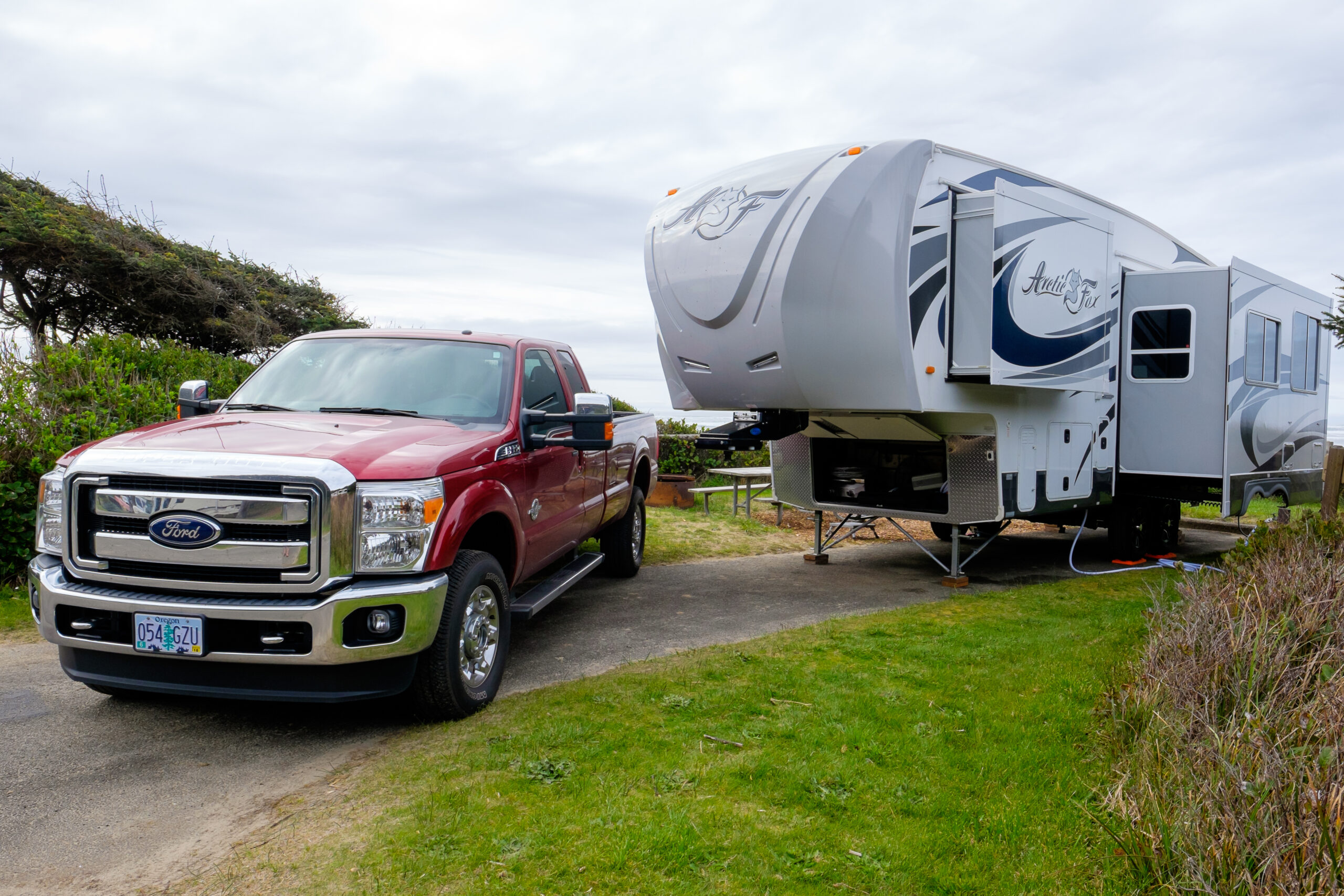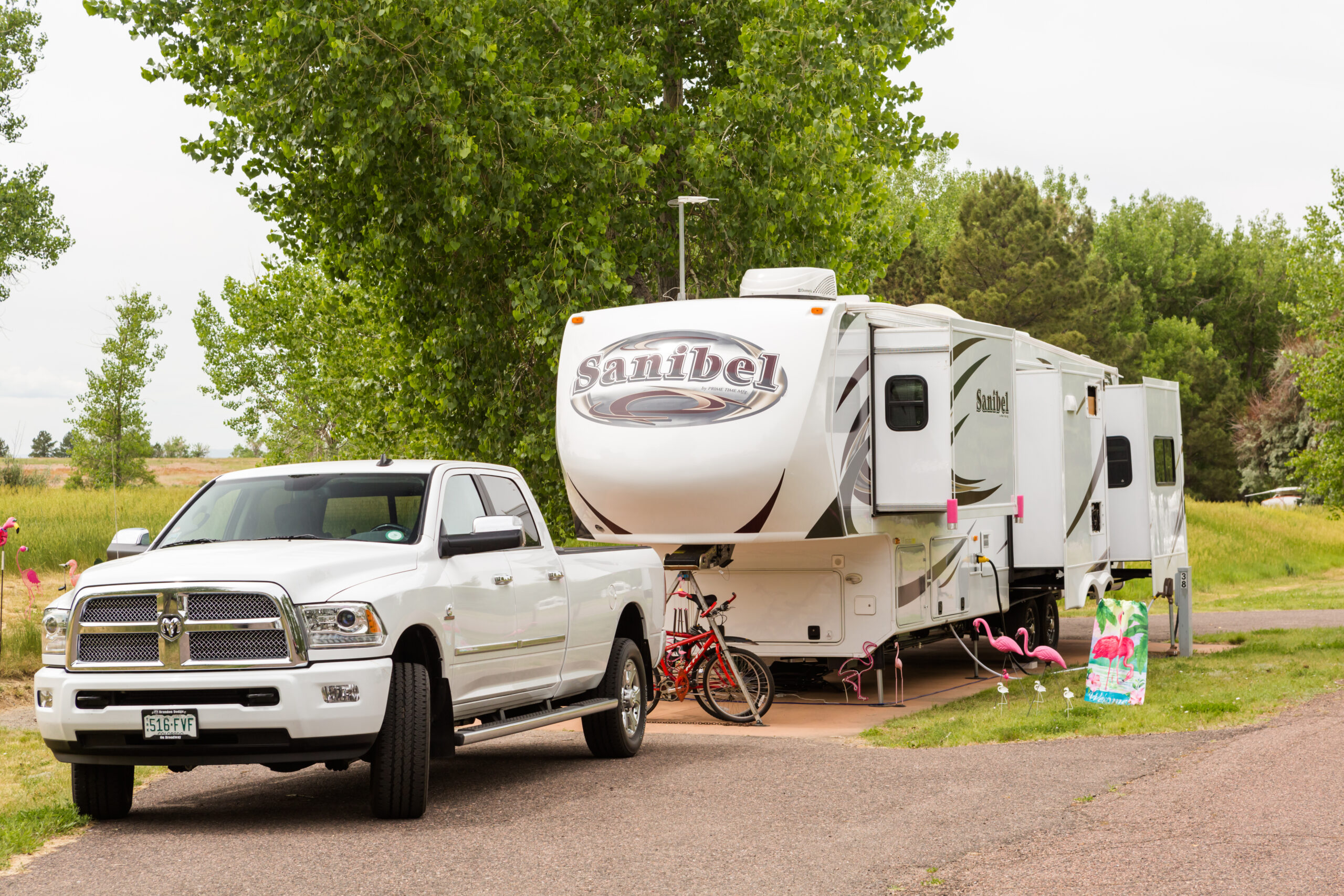
Everything You Need To Know About 5th Wheel Towing
5th wheels have some of the largest and most luxurious floor plans on the market. These RVs are quite large and bulky though, so when it comes to driving and towing, things can get tricky. Proper 5th wheel towing practices are important for the safety of the driver, the passengers, and everyone else on the road.
Below is a full guide to some of the most important ins and outs of 5th wheel towing. If you follow along with the tips below, you’ll be out on the road in no time!
Important towing limits and terms
If you’re exploring 5th wheels for the first time (or any kind of RV), there is some basic vocabulary that will be important to understand. These terms will help you understand the qualities you’re looking for in a camper and a tow vehicle.
UVW: Unladen Vehicle Weight
One important term to understand is a vehicle’s UVW. This measurement refers to the weight of a vehicle or RV when it is completely empty. It is also sometimes known as the dry weight or shipping weight. Basically, the UVW is a measurement that tells you the absolute minimum weight of a vehicle.
CCC: Cargo Carrying Capacity
This measurement isn’t always included in a vehicle’s specs information, but it’s still important to calculate. Cargo carrying capacity is exactly what it sounds like. This refers to the maximum amount of additional cargo/weight that a vehicle can safely carry.
GVWR: Gross Vehicle Weight Rating
Another important measurement to know is the gross vehicle weight rating. This is especially important when you’re dealing with heavy vehicles like a 5th wheel. The GVWR refers to the maximum weight of a vehicle when it is fully loaded with cargo, water, passengers, and anything else you might put inside. It’s the total maximum weight that a vehicle can safely be.
Note: UVW, CCC, and GVWR are all related to each other. If a specs sheet doesn’t give you one of the measurements, you can use the other two to fill in the blanks. For example, if there’s no GVWR, just add the CCC and UVW numbers to get the right result.
Tow capacity
Tow capacity is most important for the tow vehicle, but it can apply to the 5th wheel as well. This just refers to the maximum amount of weight that a vehicle can safely pull behind itself. If you plan to tow a second vehicle behind your RV, this is important to keep in mind. Try not to push the towing capacity to its absolute limit because this can damage the tow vehicle and possibly lead to crashes and breakdowns.
Payload
Finally, we have payload. This measurement is especially important for trucks, which are always used for 5th wheel towing. The payload refers to the maximum amount of weight that a truck can safely carry in its bed and cabin. 5th wheel hitches are quite heavy, so you’ll need to make sure that your tow truck’s payload can handle the weight of it.
Suitable vehicles for 5th wheel towing
As mentioned above, trucks are the tow vehicles that are compatible for hauling 5th wheels. The construction of these RVs includes an overhanging section that fits into the space above the truck bed. An SUV or other type of tow vehicle just isn’t built to fit the design, so you’ll always need to use a truck for 5th wheel towing.
However, just because you’re using a truck, that doesn’t mean your work is done. There are lots of different makes, models, and designs and you’ll need to pick a tow vehicle that matches the size and weight of your 5th wheel. Most 5th wheels weigh between 12,000-15,000 lbs, but some can be much higher. These are generally the largest and heaviest RVs on the market, so you’ll need a heavy-duty truck to transport them.
When you’re looking for a good truck/5th wheel pairing, it’s important to compare the 5th wheel’s GVWR to the truck’s maximum tow capacity. If the 5th wheel is heavier than the truck can handle, it won’t be a good match.
Standard or long bed trucks are usually the best matches for 5th wheel towing, but short-bed models can also work under some circumstances. It all comes down to the weight comparisons.
Selecting the fifth wheel hitch
We mentioned this a bit earlier, but a good 5th wheel hitch is a vital piece of equipment. They can be quite heavy, but they will help keep your RV attached and make it easier to drive with. There are two main types of 5th wheel hitches, the 5th wheel hitch and the sliding hitch. Some people also use gooseneck hitches, but these are far less common.
These hitches are fairly easy to connect to once they’re installed in the truck bed. Drivers just need to carefully line up their vehicles and back into place until the connecting pin attaches. 5th wheel hitches allow the 5th wheel to pivot around a fixed point, while sliding hitches will slide farther back into the bed of the truck, increasing clearance between the RV and truck cab when maneuvering turns or getting into or out of campsites. This helps prevent the 5th wheel from coming into contact with the truck cab, especially on shorter bed trucks.
When selecting a hitch, make sure the hitch weight doesn’t exceed your truck’s maximum payload.
Driving with a 5th wheel
Safe 5th wheel towing practices keep everyone on the roads safe. Even if you’re a very confident driver, it’s best not to push your luck when you’re driving with a massive and heavy 5th wheel behind you. Make sure you get some practice before you head out on your first long road trip.
The first thing to watch is your speed. When you have a 5th wheel in tow, your days of zooming down the highway and passing cars are pretty much over. It’s a good idea to stick to the righthand/slow traffic lane and follow the recommended speed limit for semi-trucks. This will usually be about 10 miles under the standard speed limit.
Speaking of speed, give yourself plenty of time to speed up, slow down, and take turns. You can’t control your momentum as well when you have a 5th wheel.
Making turns can also be a bit complicated. Due to the overhang of the 5th wheel, there’s a higher likelihood that you might bang the side or roof of your cab when making a tight turn. Make wide, gentle turns when possible, and get some outside help when you need to back into a parking space.
5th wheel towing might seem intimidating, but it’s really not too different than driving with other RVs at the end of the day. Just make sure you keep the vehicle weights under the maximum limits and practice safe driving habits and you’ll be good to go! Also, use an RV-safe GPS like the RV LIFE App and an RV-specific trip planning tool like RV LIFE Trip Wizard to get RV-safe GPS directions based on your vehicle’s specifications.
Related articles:



